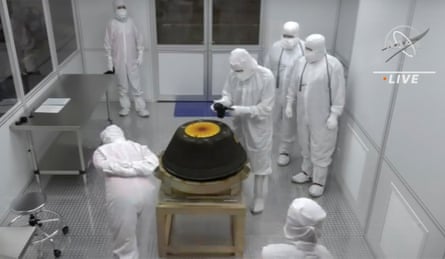Curators at Nasa’s Johnson Space Center in Houston have said they are “overjoyed” to have finally got a canister of asteroid dust open, four months after it parachuted down through the Earth’s atmosphere into the Utah desert.
The space administration announced Friday that it had successfully removed two stuck fasteners that had prevented some of the samples collected in 2020 from the 4.6bn-year-old asteroid Bennu, which is classified as a “potentially hazardous” because it has one in 1,750 chance of crashing into Earth by 2300.
Most of the rock samples collected by Nasa’s Osiris-Rex mission were retrieved soon after the canister landed in September, but additional material remaining inside a sampler head that proved difficult to access.
After months of wrestling with the last two of 35 fasteners, scientists in Houston managed to get them dislodged. “It’s open! It’s open!” Nasa’s planetary science division posted on Twitter/X. The division also posted a photograph of dust and small rocks inside the canister.
According to the Los Angeles Times, the team designed custom tools made from a specific grade of surgical, non-magnetic stainless steel to pry it open – all without the samples being contaminated by Earthly air. Nasa said it will now analyze the 9-ounce sample.
“These are some of the oldest materials formed in our solar system,” Ashley King of London’s Natural History Museum said last year.
“Samples from asteroids [such as this] tell us what all those ingredients were for making a planet like the Earth and they also tell us what the recipe was – so how did those materials come together and start mixing together to end up with [habitable environments]?” King added.

The billion-dollar spacecraft that collected the sample from Bennu, a space rock from the earliest days of the solar system, and released a canister toward Earth is now heading to a peanut-shaped asteroid named Apophis.
For a time, astronomers thought Apophis might be on track to smash into planet Earth, but those fears have diminished and scientists anticipate it will pass closer to Earth in 2029 than any object of its size ever has.
After the curation team managed to winkle the capsule open and get the remaining material out, Eileen Stansbery, division chief for Ares (Astromaterials Research and Exploration Science) at Johnson, said they were “all excited to see the remaining treasure Osiris-Rex holds”.
Dr Nicole Lunning, Osiris-Rex curator at Johnson, said in a statement: “The curation team showed impressive resilience and did incredible work to get these stubborn fasteners off the TAGSAM head so we can continue disassembly. We are overjoyed with the success.”
https://news.google.com/rss/articles/CBMiamh0dHBzOi8vd3d3LnRoZWd1YXJkaWFuLmNvbS9zY2llbmNlLzIwMjQvamFuLzIxL25hc2EtYmVubnUtYXN0ZXJvaWQtZHVzdC1yb2NrLXNhbXBsZXMtam9obnNvbi1zcGFjZS1jZW50ZXLSAWpodHRwczovL2FtcC50aGVndWFyZGlhbi5jb20vc2NpZW5jZS8yMDI0L2phbi8yMS9uYXNhLWJlbm51LWFzdGVyb2lkLWR1c3Qtcm9jay1zYW1wbGVzLWpvaG5zb24tc3BhY2UtY2VudGVy?oc=5
2024-01-21 19:47:00Z
CBMiamh0dHBzOi8vd3d3LnRoZWd1YXJkaWFuLmNvbS9zY2llbmNlLzIwMjQvamFuLzIxL25hc2EtYmVubnUtYXN0ZXJvaWQtZHVzdC1yb2NrLXNhbXBsZXMtam9obnNvbi1zcGFjZS1jZW50ZXLSAWpodHRwczovL2FtcC50aGVndWFyZGlhbi5jb20vc2NpZW5jZS8yMDI0L2phbi8yMS9uYXNhLWJlbm51LWFzdGVyb2lkLWR1c3Qtcm9jay1zYW1wbGVzLWpvaG5zb24tc3BhY2UtY2VudGVy
Tidak ada komentar:
Posting Komentar